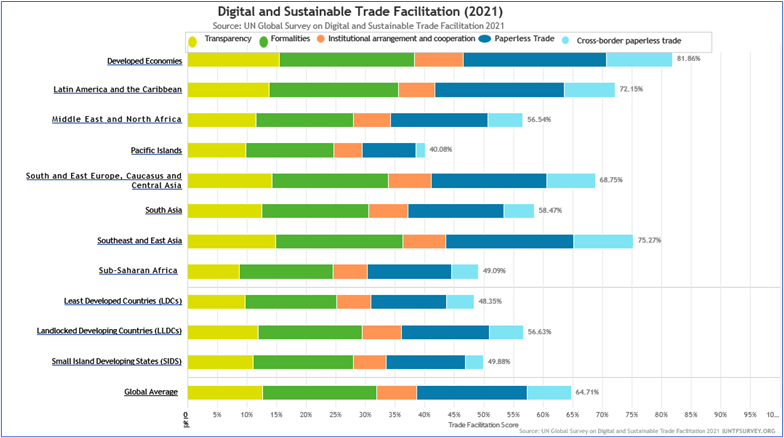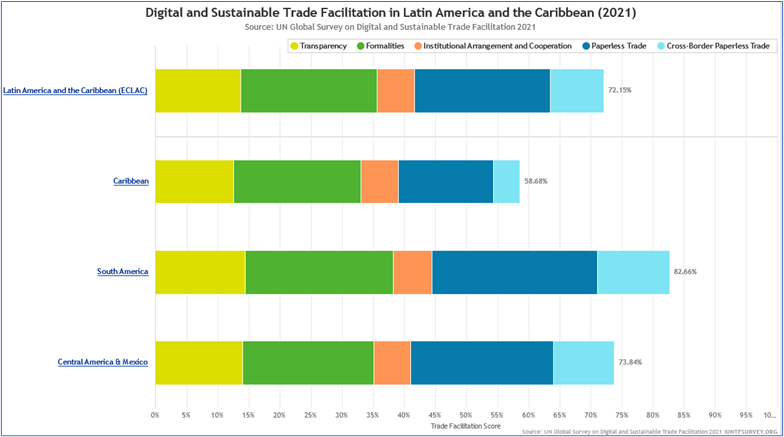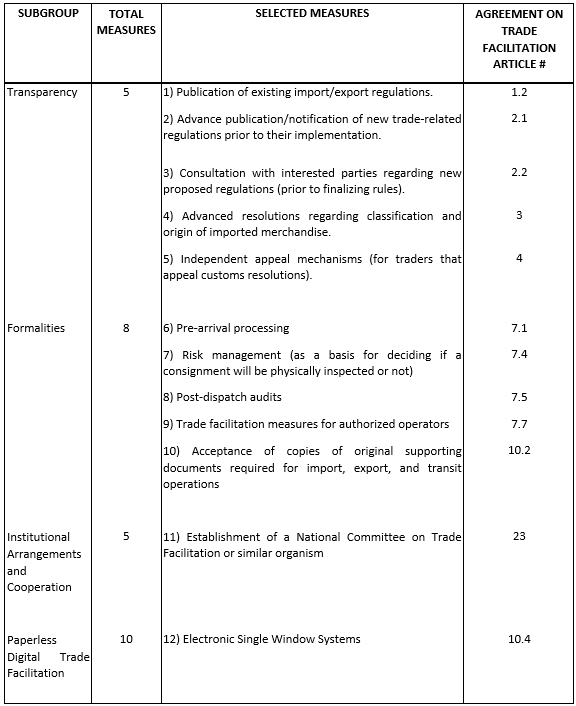A new version of the “Digital and Sustainable Trade Facilitation: Global Report 2021. Based on the United Nations Global Survey on Digital and Sustainable Trade Facilitation” was recently published. This fourth UN global survey was conducted by five United Nations Regional Commissions (UNRC) for Africa (ECA), Europe (UNECE), Asia and the Pacific (ESCAP), Latin America and the Caribbean (ECLAC) and Western Asia. (ESCWA), with the collaboration of various sub-regional organizations from different continents.
This report analyzes the progress of trade facilitation reforms in 144 countries and is based on the 2021 United Nations Global Survey on Digital and Sustainable Trade Facilitation.
The purpose of this blog is not to comment on the report. However, it will be used as a source of information to extract the following data:
a) two very illustrative graphs that measure the degree of progress in the implementation of trade facilitation measures for various geographical regions of the world and
b) some of its measures that have an impact on issues of rules of origin and their relationship with the articles of the Trade Facilitation Agreements of the WTO
The survey covers 58 trade facilitation measures that are classified into four groups and eleven subgroups. In this blog only some of the measures of the groups “General Trade Facilitation Measures” and Digital Trade Facilitation Measures will be considered. The first group includes many measures of the WTO Trade Facilitation Agreement, grouping them into three subgroups: 1) “Transparency”, 2) “Procedures” and 3) “Institutional arrangement and cooperation”. For its part, the second group includes two subgroups, 4) “Paperless trade” and 5) “Cross-border paperless trade” The results of these five subgroups will be shown in the two graphs detailed below.
The first graph compares, in percentage terms, the level of progress in compliance and enforcement of aggregate facilitation measures in the five subgroups that exist in various regions of the world. In particular, it represents the “Average rates of implementation of trade facilitation measures worldwide”.
Based on this information, for example, Latin America is in third place in the level of progress and implementation of trade facilitation measures with 72.15% compliance in all areas of foreign trade, behind the Economies Developed (81.68%) and from the countries of Southeast and East Asia (75.27%) and above the global average (64.71%).

The second graph shows the same behavior as the previous graph, but in this case, it breaks down the Latin American subtotal into subregions. This subdivision allows us to observe that the average level of implementation of trade facilitation measures in the countries of South America achieve a high percentage of compliance (82.33%), while Mexico and Central America are also at a level higher than the general average. with 73.78% while the Caribbean only reaches 58.68%.

Now, the survey includes a wide assortment of measures. Its results are indicators of the degree of implementation of all of them. In this regard, it is worth asking if the results are also representative of reality in terms of rules of origin. To respond to this concern, I have selected those measures that I believe may have an impact or be linked to the issue of rules of origin. The following table shows the measures selected from the set of those collected in the report. In numerical terms, I consider that at least 12 of the 28 measures of the four subgroups have an impact on origin.

It is worth asking if the implementation of the facilitation measures related specifically to origin in Latin America has the same level of compliance as at the global level. The UN report does not make this analysis.
Therefore, to think about an answer to this general question, I have elaborated some general questions where attention is paid to how these measures are applied in the regimes of origin of each country, considering what is established in the articles of the AFC of the WTO. In this way, it will be possible to have an approximate idea of how trade is being facilitated in relation to the issue of origin. It would not be surprising if the answer to many of these questions is negative because the trade facilitation measure is not being applied.
The higher the percentage of negative responses, the lower the compliance in implementing trade facilitation at origin. In this sense, it would be almost impossible to reach, in the case of origin, for example, in South America, the 82.33% achieved by that region. And in turn, the greater the number of negative responses, the origin will be farther from the average reached by the reference region.
Measure 1: Publication of existing regulations (laws, regulations, administrative provisions) for imports and exports related to rules of origin.
• Is the regulation of origin published quickly online and is it easily accessible to operators and authorities involved in foreign trade, through tariff-line queries?
Measure 2: Advance publication and/or notifications of new trade-related regulations before their implementation, in terms of regulations on rules of origin
• Are the changes or modifications of the requirements of origin published before their entry into force?
Measure 3: Stakeholder consultation on new draft regulations (before finalization) on origin
• Are there formally established mechanisms and procedures for consultations with private operators on new rules on origin issues ?
Measure 4: Advance ruling on tariff classification and origin of imported goods.
• Do all of a country’s free trade agreements provide for a mechanism to obtain advance rulings on origin?
Measure 5: Independent appeal mechanisms (for operators to appeal customs rulings).
• Are there, in all the country’s preferential agreements, administrative review resources for origin issues before an independent or administrative authority superior to the official or office that made the decision and/or the court?
Measure 6: Pre-arrival processing.
• Are there procedures that allow the advance presentation of certificates of origin in order to process them before the arrival of the goods?
Measure 7: Risk management as a basis for deciding whether or not a shipment will be physically inspected.
• Does the current risk management system for customs control include variables related to the origin of preferential trade?
Measure 8: Post clearance audits.
• Do all free trade agreements provide for post-clearance audits, and are their procedures and the responsibilities of each of the operators made public?
Measure 9: Trade facilitation measures for authorized operators.
• Do the control procedures established to grant the status of Authorized Economic Operator (AEO) include an assessment of whether the applicant has the capacity to produce goods that comply with the rules of origin of its main agreements?
Measure 10: Acceptance of copies of original supporting documents necessary for import and export or transit procedures.
• Is it allowed without penalty and without requiring additional information to replace an incomplete certificate of origin or with formal errors in the country’s trade agreements?
Measure 11: Establishment of a National Trade Facilitation Committee or similar body.
• Are there commissions or formal working groups of the public and private sectors to deal with the operational aspects related to the rules of origin?
Measure 12: Electronic Single Window System (ESW).
• Does the ESW have files with all the specific rules per product that can be consulted by tariff position using the current tariff nomenclature of the country?
In the next post I will answer these questions taking into account the information from customs, trade ministries, export promotion agencies of some countries and eventually some regional integration secretariats available on the INTERNET.